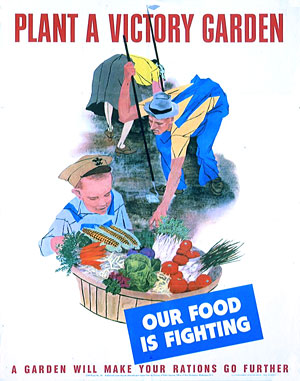Encyclopedia Dubuque
"Encyclopedia Dubuque is the online authority for all things Dubuque, written by the people who know the city best.”
Marshall Cohen—researcher and producer, CNN
Affiliated with the Local History Network of the State Historical Society of Iowa, and the Iowa Museum Association.
VICTORY GARDEN
Victory Garden. Local efforts to help win WORLD WAR II. Many Iowans planted “victory gardens” so that they could preserve their own vegetables. This provided more food to be shipped to Europe and an opportunity for children who gardened to believe they were an important part in the war effort.
As part of the war effort, the government rationed foods like sugar, butter, milk, cheese, eggs, coffee, meat and canned goods. Labor and transportation shortages made it hard to harvest and move fruits and vegetables to market. The government therefore encouraged citizens to plant "Victory Gardens" to provide their own fruits and vegetables.
An estimated 20 million Americans responded. They planted gardens in backyards, empty lots and even city rooftops. Neighbors combined their resources, planted different kinds of foods, and formed cooperatives.
Magazines such as the Saturday Evening Post and Life printed stories about victory gardens. Women's magazines gave instructions on how to grow and preserve garden produce. Families were encouraged to can their own vegetables to save commercial canned goods for the troops. In 1943, families bought 315,000 pressure cookers (used in the process of canning), compared to 66,000 in 1942. The government and businesses urged people to make gardening a family and community effort.
The US Department of Agriculture estimated that more than 20 million victory gardens were planted. Fruit and vegetables harvested in these home and community plots was estimated to be 9-10 million tons, an amount equal to all commercial production of fresh vegetables.
When World War II ended, so did the government encouragement of victory gardens. Many people did not plant a garden in the spring of 1946. Because agriculture had not yet geared up to full production for grocery stores, the country experienced some food shortages.


